How do I pick wines to bring for Thanksgiving, Brooklynguy?
What should I do, Brooklynguy, because I have to pick the wines this year?
It's my responsibility to get wine for our dinner this year, and I don't know what to get. What should I buy?
I'd be curious to hear your thoughts on Thanksgiving wines, Brooklynguy.
None of the above are questions that were asked of me, although I'm going to pretend that they were.
Here's how I pick wines for Thanksgiving - I remember that in my family, the only person who cares even a little bit about the wines is me. No one wants to discuss the wine. But they know that I'm into wine, so they expect a 2 minute explanation about the wines I brought. Not more than two minutes though, and keep it simple.
So I bring wines that I want to drink, but also wines that I imagine my family will also enjoy because they smell and taste good. And I try to keep things low in the alcohol department because there will be driving in traffic, and more importantly because I don't want it to be my fault when a family member gets awkwardly weepy and declares their firm intent to see more of the rest of us.
I like to drink sparkling cider while hanging out before the meal, and my family does too. They don't hate it, anyway. It feels festive and it's low in alcohol. Three producers whose ciders I buy without hesitation -
Julien Frémont, (Louis/Dressner Imports),
Eric Bordelet (JD Headrick Selections), and
Cyril Zangs (Savio Soares Selections). This year I'm bringing one of Bordelet's pear ciders, the 2009 Poire Authentique. At 4% alcohol, I just cannot see things getting out of hand for anyone. I'm also bringing
2009 Bisson Prosecco Treviso (Imported by Rosenthal Wine Merchant) because it's very tasty and accessible, and at 11% alcohol, this bottle will not directly result in too many abusive comments amongst my family members. None of those bottles costs more than about $15, unless you buy the fanciest Bordelet Ciders which are beautiful, but also drier than the turkey you will very shortly be forced to eat.
I'm bringing white wine too, and nothing terribly creative - Mosel Riesling, thank you very much. Why not, really? It works well with the food, the sweet orchard fruit makes people happy,and the saw-like acidity makes me happy. In my family, I seem to be the only one who drinks white wine during thanksgiving dinner, so if I want to drink
2008 Knebel Riesling Trocken and
2009 Peter Lauer Saar Riesling Barrel X, then that is exactly what I shall drink. These are both imported by Mosel Wine Merchant, cost around $15 each, and are legitimately excellent wines.
You might be surprised to hear that I am also bringing red wine this year. I would bring Beaujolais, but the ones that I like the most cost at least $20 per bottle, and I'd prefer to spend less. I know it's a bit bulkier than is ideal, but I tend to bring Loire Cabernet Franc wines to Thanksgiving dinner because people expect their red wines to be brawny and dark, and I certainly do not want to rain on my family's parade. So I'll bring
2007 Filliatreau Saumur-Champigny La Grande Vignolle, $18, Louis/Dressner Imports and
2007 Domaine Guion Bourgueil Cuvée Prestige, $14, Fruit of the Vines Imports. These wines are actually far more graceful and balanced than people might like, but they are delicious wines that will make people happy and whose spicy undertones should pair nicely with the frustrated political discourse and inappropriate career advice that will flow freely during dinner.
Hope this helps!
 The day after Christmas we got two feet of snow in my part of Brooklyn. I love the way the neighborhood looks when it's freshly blanketed in snow.
The day after Christmas we got two feet of snow in my part of Brooklyn. I love the way the neighborhood looks when it's freshly blanketed in snow. The city wasn't quite able to adequately manage snow removal, however, and there were buses and ambulances abandoned in the streets. Side streets went un-plowed for days and some people were effectively trapped in their homes.
The city wasn't quite able to adequately manage snow removal, however, and there were buses and ambulances abandoned in the streets. Side streets went un-plowed for days and some people were effectively trapped in their homes.


























































